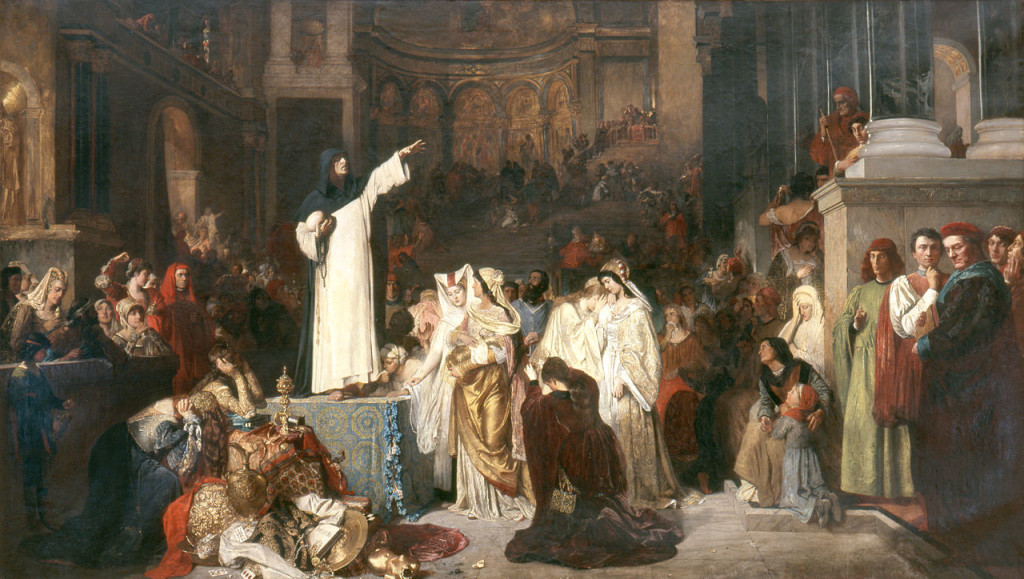When the Dominican friar Girolamo Savonarola arrived in the Italian city-state of Florence he found a culture bristling with contrasts and in moral crisis. The Renaissance began here and the city was bustling with a renewal of classical literature, philosophy, and art, but in the midst of glorious prosperity there was a profound lack of virtue and corruption of integrity. As the Italian historian Pasquale Villari describes: “Their religion was either an engine of government or a base hypocrisy: they were without faith of any kind, whether civil or religious, moral or philosophical; they were not earnest even in skepticism. Their dominant feeling was utter indifference to principle.” The citizens of Florence devoted their energies to revelry, typified by their carnivals. Lorenzo di Medici, who was called “the Magnificent” and reigned as benevolent tyrant, wrote the songs for these masquerades, consisting largely of obscenities and double entendres, while youth paraded the streets dressed in costumes flaunting their debauchery. Imagine downtown Manhattan on Halloween, except sponsored, encouraged and organized by the mayor.
This was the moral environment that Savonarola found in the early 1480s but—at least to my ears—the situation sounds startlingly familiar. The city was more prosperous than ever but its citizens were utterly indifferent to principle, apathetic even in their skepticism. They could throw a good party, and were enthralled by empty and obscene entertainment. It sounds, in some ways, like us.
Thorns of Vanities
Savonarola would later name the entertainment obsessing his fellow-citizens “vanities.” He was not the first to decry them: so does Sacred Scripture, most obviously in the book of Ecclesiastes. “Vanity of vanities, says the Preacher, vanity of vanities! All is vanity.” (Eccl 1:2) The more poetic Ronald Knox translation renders these first verses:
A shadow’s shadow, he tells us, a shadow’s shadow; a world of shadows! How is man the better for all this toiling of his, here under the sun? . . . And it was my resolve to search deep and find out the meaning of all that men do, here under the sun. . . . All that men do beneath the sun I marked, and found it was but frustration and lost labour, all of it (Eccl 1:2-3, 13-14).
The world is full of vain pursuits tempting men, and the Preacher searches them all but one by one finds them lost labor. In every thing of this world he could find no satisfaction; “What is all our striving, but a full mouth and an empty belly?” (Eccl 6:7). In other words a vanity is attractive, yet unsatisfying and unfulfilling. It is a shadow’s shadow.
Vanities are distractions. They are usually not terribly evil in themselves, though they are often occasions for greater sins, rather their chief fault lies in their ability to draw our attention away from what actually matters. They are vain: not as people might be proud but as actions might be futile. And yet because of our fallen natures they still attract us, distracting us from reality. T.S. Eliot starkly characterized this life in The Four Quartets:
Here is a place of disaffection . . .
Distracted from distraction by distraction
Filled with fancies and empty of meaning
Tumid apathy with no concentration
Christ Himself warns us of the allure of vanities, in the parable of the sower. A sower sows seed on a path, on rocky ground, amid thorns, and on good soil, but only the seed in good soil free of weeds bears fruit. The seed is the Word of God and the soil the human soul. “And the man who took in the seed in the midst of briers is the man who hears the word, but allows the cares of this world and the false charms of riches to stifle it, so that it remains fruitless” (Mt 13.22). The briers that choke the seed of the word, that kill spiritually, are the vanities which trap and suffocate. Weeds kill a plant not directly, but subtly. They overshadow it and steal the sunlight, they cover its roots and steal the water, they suck the nutrients out of the ground and leave it withering. Vanities do the same to us in the spiritual life; they are worthless pursuits that overshadow and push out the worthwhile, the Word of God.
What do you do when overgrown with weeds? Pull them out and burn them.
Savonarola’s Bonfire
Savonarola arrived in Florence and saw his flock spiritually dying, lead astray by wicked leaders and suffocated by the spiritual weeds of vanities. And so he began a process of reform, political and social as well as moral. It wasn’t until 1497, seven years after beginning his preaching, that he organized his infamous Bonfire of the Vanities symbolizing the triumph of his civil and religious reforms. He would end a related series of Lenten sermons saying:
I know that you seek Christ; He is risen, He is not here. That is to say, seek Christ in heaven; seek him not in the things of this life, neither in the things of this world; seek Him in celestial, divine and spiritual things. He is in heaven, and lo, He awaiteth you. O Christians! What do you [do] here? Seek to go where is thy head, for there shall you be blessed. . . . Walk from virtue to virtue in the present life, if you would find Christ in the next.
On the occasion of the bonfire, as certain Florentine citizens were attempting a revival of the carnivals, Savonarola’s followers went round the streets collecting vanities and saying a prayer. They collected the masks and costumes, obscene pictures and songs and other accessories of the festivals, and perhaps a few lewd poems. On the final day of the former carnivals many attended Mass celebrated by Savonarola and took part in a grand procession through town; preceded by a figure of the Infant Jesus, carved by Donatello, the procession sang hymns and collected alms for the poor. They ended in a large plaza where the vanities had been earlier piled into a pyramid, and at a signal the four corners of the pile were ignited, the trumpets sounded and the bells pealed, and the great crowd let out a shout of joy.
The Bonfire of the Vanities was a dramatic gesture, to say the least. It was operatic, theatrical, over the top; obviously today’s culture could never support it. But Florence in the Renaissance was an operatic time. Remember, the former ruler of the city was called “Lorenzo the Magnificent” and spent his free time writing lewd poetry for the citizens to sing, and in that environment a bonfire was a natural conclusion to a reformation of morals. It seemed so natural, in fact, that there is very little documentation of it from Savonarola’s contemporaries. Villari recounts that “in the almost numberless writings in favour or abuse of the Friar, in which every subject and fact was discussed lending itself to his attack or defense, this event was almost entirely passed over. But this has not been the case with modern writers.” Although Savonarola has always has been extraordinarily controversial, he was opposed for other reasons, and the bonfire was a mere footnote to his reformation of the morals and politics of Florence.
In the modern imagination, however, the Bonfire of the Vanities looms large. And so it is well worth addressing some of the misconceptions that surround modern accounts of the event. First, it was never a rejection of art. We have the witness of many artists who were Savonarola’s friends and followers, especially the painter Fra Bartolommeo who became a Dominican expressly to follow Savonarola. Moreover, Savonarola himself lived in the convent of San Marco so beautifully illuminated by Fra Angelico. He was no stranger to beauty.
Neither was the Bonfire a rejection of learning, as it has been so often portrayed or imitated in modern literature. On the contrary, poets and philosophers would be counted among Savonarola’s admirers. Most notably, he had around the same time—at great financial risk to the convent—acquired the Medici’s extensive library which was perilously close to being dispersed to settle public debts. Rather than see such a treasure of learning lost, Savonarola sold much of the convent’s land to keep the manuscripts open to the public. He worked to increase learning, not arrest it. Eyewitness accounts, as sparse and exaggerated as they are, agree: the Bonfire was in no way equivalent to the bonfires we find in dystopian literature. This was not Fahrenheit 451.
The Burning of the Vanities was no barbarism, but a symbol of Florence’s reformation of morals. Principally, it was an honest awareness that some things are vanities, occasions of sin that support aimless lifestyles detrimental to a life of virtue. It embraced a realism that there are cultural products that only mislead and distract, capable of smothering the spiritual life. There are some frivolities that simply do not deserve our attention, do not deserve a place in our lives, and do not deserve to exist in our cities.
We are quick to judge Savonarola’s actions, in part because we live in an age very different from his. The Renaissance loved the dramatic and theatrical, while the post-Christian West is anything but dramatic; we jealously guard our privacy and we value the efficient, quiet solution. But there is a deeper reason why we are quick to judge. In other ways our culture mirrors that of Florence: in its public embrace of vice, distraction by entertainment, and obsession with vanities. To approve of Savonarola’s bonfire is to admit that we may need a little bonfire ourselves.
A Modern Vanity
Florence’s vanities were typified by the carnivals, which is why Savonarola burned their accessories as a symbolic rejection of vanity itself. We love our entertainment, but public carnivals are harder to come by in our day. Instead, our vanities might be typified and symbolized by the smartphone.
The smartphone is an incredibly powerful tool; we shouldn’t pretend it hasn’t expanded human knowledge and connected otherwise disparate persons. But in daily life we use it trivially. Imagine explaining the smartphone to one of the great thinkers of the past: Bell, or Newton, or even the medieval and ancient philosophers. “I have in my pocket a device on which I can access the vast store of human knowledge, read the classic works of literature, and listen to the greatest music ever composed. I use it mostly to look up videos of cats and get in pointless political arguments with strangers.” It is hard to imagine a greater tool used more poorly than the smartphone, something so powerful used in vain.
As entertainment, the smartphone is the quintessential vanity; it provides a shadow of real life, it is “filled with fancies and empty meaning,” it is a “full mouth with an empty belly.” What better way to be “distracted from distraction by distraction” than with something you never have to leave behind and always provides a new triviality? And this is not even to mention the filth and obscenities permeating the internet. Smartphones certainly dispose us to ignore the good. But perhaps the greatest danger is that phones can destroy our ability to be quiet. The person who is always occupied with busyness is unable to discern the good and move towards it, he is distracted and, just like a distracted driver, prone to err to the point of spiritual death. Filled with noise, it is doubtful he will even notice his life falling apart.
Silence is necessary for self-knowledge, and ultimately, happiness and existential satisfaction. This quiet attention to the self is not narcissistic but athletic, to use one of St. Paul’s metaphors: “every athlete exercises self-control in all things. They do it to receive a perishable wreath, but we an imperishable.” (1 Cor 9:25) Self-control, in the spiritual life as well as the physical, requires an attentiveness to the self. This makes it possible to truly know who I am, to be honest about my weaknesses and strengths, to be comfortable in my own skin while being aware of what I am lacking. It is to be present in the moment, in my own soul.
Being attentive to others also requires silence. Clearly without some degree of interior silence there can be no true listening, one can never be fully present to another person. According to research done at Essex University by Andrew K. Przybylski and Netta Weinstein, the mere presence of a phone on the table—even turned off and unused—can degrade the ability to connect and empathize with another person. “The presence of a diverting influence such as a mobile phone may inhibit relationship formation by reducing individuals’ engagement and attention for their [conversation] partners.” Phones symbolize and are unconsciously linked to online activities, and they “can direct attention away from face-to-face conversations by making concerns about maintaining wider social networks salient.” The effect is so appreciable that it can be scientifically demonstrated: phones, even unused, pull our attention away from the person in front of us into shadowy distant interactions.
Most importantly, we need silence to hear God. If we cannot be attentive to someone we can see in the flesh, how can we hope to respond to a God that speaks in whispers more often than thunderclaps? Those who sought the Lord entirely have always sought solitude and silence: from the first desert hermits to the monastic orders holy men and women have found God in deserted places. Few are able to choose such a radical life of contemplation, but the principle is the same for those with more active lives. God has planted His Word in the soul as a spring welling up truths of eternal life, but that spring is often clogged with trash.
Removing that trash in order to be attentive to ourselves, to others, and to God is a goal we share in common with Savonarola. But as he lived in a different time, his Bonfire has a very different character. It was theatrical and dramatic, a public event in an explicitly Catholic state. We live in a quieter, more desperate time. We do not have the option of a single grand gesture to symbolize a new mode of life, and we cannot have the support of the state in our life of virtue.
Lighting a New Bonfire
So what form should our bonfire take? Probably not a physical fire, plastic doesn’t burn well. For some getting rid of a smartphone is simply not an option, it is too useful and too integrated into daily life and work (though in reality more could part ways with it than are willing to admit).
Instead the use of smartphones should be moderated and controlled to cultivate silence in life. There should be times and places where no smartphones or other screens are allowed: in the bedroom, at dinner time, especially in those places where it is important to be attentive. We have to rediscover how to relax, how to enjoy quiet leisure instead of perpetually needing to be entertained. There will be some discomfort as we attempt to reintroduce silence; most of us have forgotten how to be quiet and most of us are distracting ourselves from at least one or two problems. Silence forces us to confront reality, which is undoubtedly good and healthy but not always comfortable. Most importantly, we ought to reclaim the joys of being fully present with another person, we have to remember how to give and receive attention. I believe that we will find more love and support in those around us than we anticipate, and becoming attentive to reality we will learn to see our entertainments as truly petty.
It may seem farfetched to compare our moderation of smartphones with Florence’s bonfire. But each is fitted to the signs of very different times, and our time is characterized by a quiet and desperate, even pitiful, individualism. To live and work within the modern world may require, to some extent, a participation in its vanities but it is easy to overestimate how necessary those concessions are, and underestimate how desired and in reality unneeded they can be. Most who rely on smartphones and other technologies could, with a little effort, learn to live without that vanity. Little by little each weed is pulled out and tossed on the bonfire, and as we expunge vanities we progress towards a life that is not vain but fruitful.
Savonarola’s Notorious Reforms
The citizens of Florence burned their vanities at Savonarola’s urging, but the vanities they embraced were hardly their only vice. The terrible example of prelates—bishops living like princes and popes living in public sin—had for decades made a deep impression on Christians. Combined with the involvement of secular rulers in the Church hierarchy, it fostered an apathy towards the faith. These were the primary targets of Savonarola’s preaching and the cause of the controversies that enveloped his ministry.
In the first years of his reform Savonarola made several decisive interventions in Florentine politics culminating in a complete restructuring of the city-state’s government as a democracy, ruled by a council with Jesus Christ named as the King of Florence. Endeavoring to preserve its newfound freedoms, Florence cast itself against the major European powers of the time, including the Papal States. Savonarola’s leadership and his outspoken support of Florentine independence gained him many political enemies through the years.
In his preaching Savonarola was constantly calling for a reform of morals not only among the laity but especially among the clergy. Pope Alexander VI, of the infamous Borgia family, was an able political leader but entirely corrupt. His papal election was widely believed to have been bought, he fathered at least four children of various mistresses and openly promoted them in the Church hierarchy. Corruption and vice reigned. All this led Savonarola to openly challenge clerics to reform; in one self-described “terrifying sermon” he proclaimed:
Fathers make sacrifice to this false idol, urging their sons to enter the ecclesiastical life, in order to obtain benefices and prebends; and thus you hear it said: Blessed the house that owns a fat cure. But I say unto you: A time will come when rather it will be said: Woe to that house; and you will feel the edge of the sword upon you . . . you forsake me, you deride me, yet I shall gain a few disciples who will give up all for Christ’s sake. They will ask neither benefices nor prebends . . . they will not seek the great . . . they will not visit women daily.
Savonarola’s candid insistence denouncing vice earned him many enemies. Eventually they fought back, using the devious and corrupt practices that Savonarola despised; they misrepresented him to the Pope and incited anger against him in ecclesiastical courts. A long drama ensued featuring assassination attempts, riots in the church during his sermons, armed occupations of his convent, and at one point a plan to blow up his pulpit with fireworks. In the midst of these spectacles the Bonfire of Vanities fits well. But the story has a tragic ending, one which Savonarola predicted more than once.
On May 12, 1497, Pope Alexander VI issued an excommunication against Savonarola, the validity of which is still contested and unsettled to this day. And a year later when it became politically expedient, the secular rulers arrested him and two of his Dominican brothers and put them to death.
Savonarola, as recounted by J. L. O’Neill O.P., once wrote that “my departure from the city would be an occasion of grave danger [to the moral life of Florence].” His words proved true; after his death Florence returned to a life of discord and dissipation. Can we fare any better?
To download a printable PDF of this Article from
Dominicana Journal, Summer 2016, Vol. LIX, No. 1, CLICK HERE.




